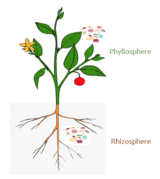Spermosphere
| Part of a series on |
| Microbiomes |
|---|
 |
Introduction
[edit]In plant science, the spermosphere is the zone surrounding a seed where soil, microorganisms, and seed germinating interact.[1] The zone is a small area, typically 1–10 mm from the seed, but varying with seed type, the variety of soil microorganisms, the level of soil moisture, and other factors.[2]
Importance
[edit]Within the spermosphere, a range of complex interactions take place among the germinating seed, the soil, and the microbiome.[3][1] Because germination is a brief process, the spermosphere is transient, but the impact of the microbial activity within the spermosphere can have strong and long-lasting effects on the developing plant.[3] The spermosphere can even have impacts on managing stress during germination, as seen with Bacillus strains and peanut plants.[4]
Factors that influence spermosphere
[edit]Seeds exude various molecules that influence their surrounding microbial communities, either inhibiting or stimulating their growth.[1][3] The composition of the exudates varies according to the plant type and such properties of the soil as its pH and moisture content. Soil type matters much more than seed type, specifically soil with a higher content of organic matter.[5]
With these biochemical effects, the spermosphere develops both downward—to form the rhizosphere (upon the emergence of the plant's radicle)[3]—and upward to form the laimosphere, which is the soil surrounding the growing plant stem, and the phyllosphere, which is the microbial community on the part of the plant above the soil. Specifically, the floral microbiota can play a role in the composition of the spermosphere like in plants such as wheat[6], grapevine[7], and rice[8]. As the seed germinates, the function of the microbial community changes rather than its composition.[5]
Protection of the seed
[edit]The spermosphere also acts as biological control for the germinating seed which means certain beneficial microorganisms can protect the seed from plant pathogens. Many plant pathogens such as Fusarium and Pythium ultimum can colonize a newly germinating seed within the first few hours of planting.[9] The seed can exudate molecules and nutrients that attract beneficial microorganisms to their spermosphere which then prevent the colonization of pathogens.[5] There has been specific research in this area with cottonseeds in which they were coated with a beneficial bacteria which prevented the seed from being infected with a Pythium ultimum infection.[10]
References
[edit]- ^ a b c Schiltz, S.; Gaillard, I.; Pawlicki-Jullian, N.; Thiombiano, B.; Mesnard, F.; Gontier, E. (December 2015). "A review: what is the spermosphere and how can it be studied?". Journal of Applied Microbiology. 119 (6): 1467–1481. doi:10.1111/jam.12946. ISSN 1365-2672. PMID 26332271.
- ^ Beattie, Gwyn A. (2006). "Plant-Associated Bacteria: Survey, Molecular Phylogeny, Genomics and Recent Advances". In Gnanamanickam, Samuel S. (ed.). Plant-associated bacteria. Vol. 1. Springer Publishing. p. 2. doi:10.1007/978-1-4020-4538-7_1. ISBN 978-1-4020-4538-7.
- ^ a b c d Schiltz, S; Gaillard, I; Pawlicki-Jullian, N; Thiombiano, B; Mesnard, F; Gontier, E (December 2015). "A review: what is the spermosphere and how can it be studied?". Journal of Applied Microbiology. 119 (6): 1467–81. doi:10.1111/jam.12946. PMID 26332271.
- ^ Xu, Yang; Zhang, Dai; Dai, Liangxiang; Ding, Hong; Ci, Dunwei; Qin, Feifei; Zhang, Guanchu; Zhang, Zhimeng (January 2020). "Influence of Salt Stress on Growth of Spermosphere Bacterial Communities in Different Peanut (Arachis hypogaea L.) Cultivars". International Journal of Molecular Sciences. 21 (6): 2131. doi:10.3390/ijms21062131. ISSN 1422-0067. PMC 7139419. PMID 32244906.
- ^ a b c Buyer, Jeffrey S; Roberts, Daniel P; Russek-Cohen, Estelle (1999-02-01). "Microbial community structure and function in the spermosphere as affected by soil and seed type". Canadian Journal of Microbiology. 45 (2): 138–144. doi:10.1139/w98-227. ISSN 0008-4166.
- ^ Elbeltagy, Adel; Nishioka, Kiyo; Suzuki, Hisa; Sato, Tadashi; Sato, Yo-Ichiro; Morisaki, Hisao; Mitsui, Hisayuki; Minamisawa, Kiwamu (September 2000). "Isolation and characterization of endophytic bacteria from wild and traditionally cultivated rice varieties". Soil Science and Plant Nutrition. 46 (3): 617–629. doi:10.1080/00380768.2000.10409127. ISSN 0038-0768.
- ^ Compant, Stéphane; Mitter, Birgit; Colli-Mull, Juan Gualberto; Gangl, Helmut; Sessitsch, Angela (2011-07-01). "Endophytes of Grapevine Flowers, Berries, and Seeds: Identification of Cultivable Bacteria, Comparison with Other Plant Parts, and Visualization of Niches of Colonization". Microbial Ecology. 62 (1): 188–197. doi:10.1007/s00248-011-9883-y. ISSN 1432-184X.
- ^ Toumatia, O.; Compant, S.; Yekkour, A.; Goudjal, Y.; Sabaou, N.; Mathieu, F.; Sessitsch, A.; Zitouni, A. (2016-07-01). "Biocontrol and plant growth promoting properties of Streptomyces mutabilis strain IA1 isolated from a Saharan soil on wheat seedlings and visualization of its niches of colonization". South African Journal of Botany. 105: 234–239. doi:10.1016/j.sajb.2016.03.020. ISSN 0254-6299.
- ^ Nelson, Eric B. (1990-12-01). "Exudate molecules initiating fungal responses to seeds and roots". Plant and Soil. 129 (1): 61–73. doi:10.1007/BF00011692. ISSN 1573-5036.
- ^ Leite, Hianna Almeida Câmara; Silva, Anderson Barbosa; Gomes, Fábio Pinto; Gramacho, Karina Peres; Faria, José Cláudio; de Souza, Jorge Teodoro; Loguercio, Leandro Lopes (2013-03-01). "Bacillus subtilis and Enterobacter cloacae endophytes from healthy Theobroma cacao L. trees can systemically colonize seedlings and promote growth". Applied Microbiology and Biotechnology. 97 (6): 2639–2651. doi:10.1007/s00253-012-4574-2. ISSN 1432-0614.
